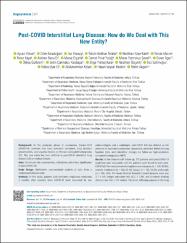Post-covid interstitial lung disease: How do we deal with this new entity?

View/
Access
info:eu-repo/semantics/openAccesshttp://creativecommons.org/licenses/by-nc-nd/3.0/us/Date
2024Author
Yüksel, AycanKaradoğan, Dilek
Hürsoy, Nur
Telatar, Tahsin Gökhan
Kabil, Neslihan Köse
Marım, Feride
Kaya, İlknur
Şenel, Merve Yumrukuz
Metadata
Show full item recordAbstract
Background: In the postacute phase of coronavirus disease-2019 (COVID-19), survivors may have persistent symptoms, lung function abnormalities, and sequelae lesions on thoracic computed tomography (CT). This new entity has been defined as post-COVID interstitial lung disease (ILD) or residual disease. Aims: To evaluate the characteristics, risk factors and clinical significance of post-COVID ILD. Study Design: Multicenter cross-sectional analysis of data from a randomized clinical study. Methods: In this study, patients with persistent respiratory symptoms 3 months after recovery from COVID-19 were evaluated by two pulmonologists and a radiologist. post-COVID ILD was defined as the presence of respiratory symptoms, hypoxemia, restrictive defect on lung function tests, and interstitial changes on follow-up high-resolution computed tomography (HRCT). Results: At the three-month follow-up, 375 patients with post-COVID-19 syndrome were evaluated, and 262 patients were found to have post-COVID ILD. The most prevalent complaints were dyspnea (n = 238, 90.8%), exercise intolerance (n = 166, 63.4%), fatigue (n = 142, 54.2%), and cough (n = 136, 52%). The mean Medical Research Council dyspnea score was 2.1 ± 0.9, oxygen saturation was 92.2 ± 5.9%, and 6-minute walking distance was 360 ± 140 meters. The mean diffusing capacity of the lung for carbon monoxide was 58 ± 21, and the forced vital capacity was 70% ± 19%. Ground glass opacities and fibrotic bands were the most common findings on thoracic HRCT. Fibrosis-like lesions such as interlobular septal thickening and traction bronchiectasis were observed in 38.3% and 27.9% of the patients, respectively. No honeycomb cysts were observed. Active smoking [odds ratio (OR), 1.96; 95% confidence interval (CI), 1.44-2.67), intensive care unit admission during the acute phase (OR, 1.46; 95% CI, 1.1-1.95), need for high-flow nasal oxygen (OR, 1.55; 95% CI, 1.42-1.9) or non-invasive ventilation (OR, 1.31; 95% CI, 0.8-2.07), and elevated serum lactate dehydrogenase levels (OR, 1.23; 95% CI 1.18-1.28) were associated with the development of post-COVID ILD. At the 6-month follow-up, the respiratory symptoms and pulmonary functions had improved spontaneously without any specific treatment in 35 patients (13.4%). The radiological interstitial lesions had spontaneously regressed in 54 patients (20.6%). Conclusion: The co-existence of respiratory symptoms, radiological parenchymal lesions, and pulmonary functional abnormalities which suggest a restrictive ventilatory defect should be defined as post-COVID-19 ILD. However, the term “fibrosis” should be used carefully. Active smoking, severe COVID-19, and elevated lactate dehydrogenase level are the main risk factors of this condition. These post-COVID functional and radiological changes could disappear over time in 20% of the patients.
Source
Balkan Medical JournalVolume
41Issue
5URI
https://doi.org/10.4274/balkanmedj.galenos.2024.2024-3-82https://hdl.handle.net/20.500.12462/15450
Collections
The following license files are associated with this item:


















